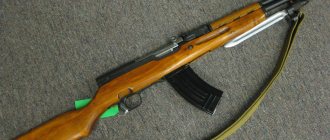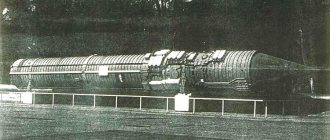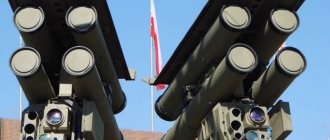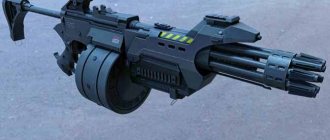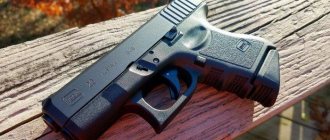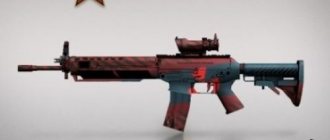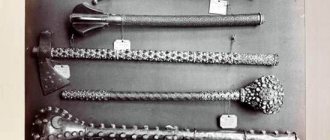The first representative of a new type of nuclear weapon is a neutron munition, which in its intended purpose belongs to tactical nuclear weapons. It is also possible that other types of tactical nuclear weapons will appear, for example, with an increased damaging effect on the shock wave, but with a reduced impact of other damaging factors.
Neutron ammunition (Fig. 1.6) is a small-sized thermonuclear charge with a power of no more than 10 thousand tons, in which the main share of energy is released due to the fusion reactions of deuterium and tritium nuclei, and the amount of energy obtained as a result of the fission of heavy nuclei in the detonator is minimal , but sufficient to initiate synthesis reactions. The neutron component of the penetrating radiation from such a low-power nuclear explosion will have the main damaging effect on personnel.
Diagram of the design of a “gun” type neutron ammunition
Rice. 1.6. Diagram of the design of a “gun” type neutron ammunition:
- 1 — ammunition housing with a plasma retention system in the reaction zone;
- 2 - mixture of deuterium and tritium;
- 3—neutron reflector;
- 4 — charge Pu-239;
- 5 — explosive charge;
- 6 — detonator;
- 7 - neutron sources
Unlike high-yield thermonuclear munitions with lithium deuteride, it is considered preferable to use a mixture of deuterium and tritium in neutron munitions. It is considered unprofitable to produce tritium during nuclear reactions, since this is associated with a significant consumption of the resulting neutrons interacting with lithium (see formula 1.3).
6 4 Li + n -> He + 4.8 MeV (1.3) 3 2
Tritium and deuterium can be included in the charge in the form of a solid metal hydride or contained in a compressed gaseous state. For explosions of ultra-low and low power ammunition, relatively little is required (Table 1.2).
Table 1.2 Calculated quantities of deuterium-tritium mixture and tritium required to carry out explosions of various powers, g TNT equivalent of explosion, thousand tons 0.1 0.2 0.5 1 2 Mixture composition D+T 1.3 2.5 7 13 25 T 0.8 1.5 4 8 15
For a neutron munition at the same distance from the epicenter of the explosion, the dose of penetrating radiation is approximately 5-10 times greater than for a fission charge of the same power. The neutron charge can be carried by an artillery shell of 203.2 mm caliber, as well as a warhead for the Lance missile.
Nuclear ammunition of all types, depending on the power, are divided into ultra-small (less than 1 thousand tons), small (1-10 thousand tons), medium (10-100 thousand tons), large (100-1000 thousand tons) and ultra-large (more than 1000 thousand tons).
The type of explosion (underground, ground, air, high-altitude, underwater, surface) is determined by the tasks of using nuclear weapons, the properties of the objects affected, their security, as well as the characteristics of the nuclear charge carrier.
Rice. 1.7. Shares of the energy of a nuclear explosion attributable to its damaging factors
Rice. 1.7. Shares of the energy of a nuclear explosion attributable to its damaging factors
The characteristics of the damaging effects of a nuclear explosion and the main damaging factor are determined not only by the type of nuclear weapon, but also by the power of the explosion, the type of explosion and the nature of the affected object (target). All these factors are taken into account when assessing the effectiveness of a nuclear strike and developing the content of measures to protect troops and facilities from nuclear weapons.
On the picture 1.7 for fission charges with small thermonuclear additives, depending on the explosion height H (km) or the reduced explosion depth (reduced explosion depth H', m/(t1/3)), equal to the ratio of the charge placement depth H, m, to the cubic root of nuclear explosion power q1/3, t1/3), the shares of energy Ei/Eo of the total explosion energy attributable to the 1st damaging factor are shown.
For example, during a nuclear explosion in dense layers of the atmosphere at altitudes up to 10 km, 35% of the total energy of the explosion is spent on the formation of an air shock wave and light radiation, 5% on penetrating radiation and 7% on radioactive contamination; about 18% of the energy will be dissipated in the surrounding space in the form of heat from the explosion cloud after its glow ceases. With changes in the properties of the environment, these relationships will change. When a neutron munition explodes, up to 70% of the energy will be spent on the formation of penetrating radiation by reducing its consumption on other damaging factors.
Fire ball
It would seem that even soft radiation moving at the speed of light should leave the matter that generated it far behind, but this is not so: in cold air, the range of quanta of Kev energies is centimeters, and they do not move in a straight line, but change the direction of movement, re-emitting with every interaction.
Quanta ionize the air and spread through it, like cherry juice poured into a glass of water. This phenomenon is called radiative diffusion. A young fireball of a 100 kt explosion a few tens of nanoseconds after the end of the fission burst has a radius of 3 m and a temperature of almost 8 million Kelvin. But after 30 microseconds its radius is 18 m, although the temperature drops below a million degrees. The ball devours space, and the ionized air behind its front hardly moves: radiation cannot transfer significant momentum to it during diffusion. But it pumps enormous energy into this air, heating it, and when the radiation energy runs out, the ball begins to grow due to the expansion of hot plasma, bursting from the inside with what used to be a charge. Expanding, like an inflated bubble, the plasma shell becomes thinner. Unlike a bubble, of course, nothing inflates it: there is almost no substance left on the inside, it all flies from the center by inertia, but 30 microseconds after the explosion, the speed of this flight is more than 100 km/s, and the hydrodynamic pressure in the substance — more than 150,000 atm! The shell is not destined to become too thin; it bursts, forming “blisters”.
Neutron source In a vacuum neutron tube, a pulse voltage of one hundred kilovolts is applied between a tritium-saturated target (cathode) 1 and anode assembly 2. When the voltage is maximum, it is necessary that deuterium ions be between the anode and cathode, which need to be accelerated. An ion source is used for this. An ignition pulse is applied to its anode 3, and the discharge, passing along the surface of deuterium-saturated ceramic 4, forms deuterium ions. Having accelerated, they bombard a target saturated with tritium, as a result of which an energy of 17.6 MeV is released and neutrons and helium-4 nuclei are formed. In terms of particle composition and even energy output, this reaction is identical to fusion - the process of fusion of light nuclei. In the 1950s, many believed so, but later it turned out that a “disruption” occurs in the tube: either a proton or a neutron (which makes up the deuterium ion, accelerated by an electric field) “gets stuck” in the target nucleus (tritium). If a proton gets stuck, the neutron breaks away and becomes free.
Which of the mechanisms of transferring the energy of the fireball to the environment prevails depends on the power of the explosion: if it is large, the main role is played by radiation diffusion; if it is small, the expansion of the plasma bubble plays a major role. It is clear that an intermediate case is possible when both mechanisms are effective.
The process captures new layers of air; there is no longer enough energy to strip all the electrons from the atoms. The energy of the ionized layer and fragments of the plasma bubble runs out; they are no longer able to move the huge mass in front of them and noticeably slow down. But what was air before the explosion moves, breaking away from the ball, absorbing more and more layers of cold air... The formation of a shock wave begins.
Protection
Neutron ammunition was developed in the 1960s and 1970s, mainly to increase the effectiveness of hitting armored targets and manpower protected by armor and simple shelters. Armored vehicles of the 1960s, designed taking into account the possibility of using nuclear weapons on the battlefield, are extremely resistant to all their damaging factors.
Naturally, after reports appeared about the development of neutron weapons, methods of protection against them began to be developed. New types of armor have been developed, which are already capable of protecting equipment and its crew from the flow of neutrons. For this purpose, sheets with a high content of boron, which is a good neutron absorber, are added to the armor (for the same reason, boron is one of the main structural materials of reactor neutron absorber rods), and depleted uranium is added to the armor steel. In addition, the composition of the armor is selected so that it does not contain chemical elements that produce strong induced radioactivity under the influence of neutron irradiation.
It is quite possible that such protection will be effective against quite possible neutron guns, which also use fluxes of high-energy neutrons.
Puff with sugar
In mid-1946, Teller proposed another hydrogen bomb design - the “alarm clock”. It consisted of alternating spherical layers of uranium, deuterium and tritium. During the nuclear explosion of the central charge of plutonium, the necessary pressure and temperature were created for the start of a thermonuclear reaction in other layers of the bomb. However, the “alarm clock” required a high-power atomic initiator, and the United States (as well as the USSR) had problems producing weapons-grade uranium and plutonium.
In the fall of 1948, Andrei Sakharov came to a similar scheme. In the Soviet Union, the design was called “sloyka”. For the USSR, which did not have time to produce weapons-grade uranium-235 and plutonium-239 in sufficient quantities, Sakharov’s puff paste was a panacea. And that's why.
In a conventional atomic bomb, natural uranium-238 is not only useless (the neutron energy during decay is not enough to initiate fission), but also harmful because it eagerly absorbs secondary neutrons, slowing down the chain reaction. Therefore, 90% of weapons-grade uranium consists of the isotope uranium-235. However, neutrons resulting from thermonuclear fusion are 10 times more energetic than fission neutrons, and natural uranium-238 irradiated with such neutrons begins to fission excellently. The new bomb made it possible to use uranium-238, which had previously been considered a waste product, as an explosive.
The highlight of Sakharov’s “puff pastry” was also the use of a white light crystalline substance, lithium deuteride 6LiD, instead of acutely deficient tritium.
As mentioned above, a mixture of deuterium and tritium ignites much more easily than pure deuterium. However, this is where the advantages of tritium end, and only disadvantages remain: in its normal state, tritium is a gas, which causes difficulties with storage; tritium is radioactive and decays into stable helium-3, which actively consumes much-needed fast neutrons, limiting the bomb's shelf life to a few months.
Non-radioactive lithium deutride, when irradiated with slow fission neutrons - the consequences of an atomic fuse explosion - turns into tritium. Thus, the radiation from the primary atomic explosion instantly produces a sufficient amount of tritium for a further thermonuclear reaction, and deuterium is initially present in lithium deutride.
It was just such a bomb, RDS-6s, that was successfully tested on August 12, 1953 at the tower of the Semipalatinsk test site. The power of the explosion was 400 kilotons, and there is still debate over whether it was a real thermonuclear explosion or a super-powerful atomic one. After all, the thermonuclear fusion reaction in Sakharov’s puff paste accounted for no more than 20% of the total charge power. The main contribution to the explosion was made by the decay reaction of uranium-238 irradiated with fast neutrons, thanks to which the RDS-6s ushered in the era of the so-called “dirty” bombs.
The fact is that the main radioactive contamination comes from decay products (in particular, strontium-90 and cesium-137). Essentially, Sakharov’s “puff pastry” was a giant atomic bomb, only slightly enhanced by a thermonuclear reaction. It is no coincidence that just one “puff pastry” explosion produced 82% of strontium-90 and 75% of cesium-137, which entered the atmosphere over the entire history of the Semipalatinsk test site.
A start
In April 1903, the famous French physicist Paul Langevin's friends gathered in the Paris Garden. The reason was the defense of the dissertation of the young and talented scientist Marie Curie. Among the distinguished guests was the famous English physicist Sir Ernest Rutherford. In the midst of the fun, the lights were turned off. Marie Curie announced to everyone that there would be a surprise. With a solemn look, Pierre Curie brought in a small tube with radium salts, which shone with a green light, causing extraordinary delight among those present. Subsequently, the guests heatedly discussed the future of this phenomenon. Everyone agreed that radium would solve the acute problem of energy shortages. This inspired everyone for new research and further prospects. If they had been told then that laboratory work with radioactive elements would lay the foundation for the terrible weapons of the 20th century, it is not known what their reaction would have been. It was then that the story of the atomic bomb began, killing hundreds of thousands of Japanese civilians.
How a neutron bomb works - features of its damaging factors
A neutron bomb is a type of nuclear weapon, the main damaging factor of which is the flow of neutron radiation. Contrary to popular belief, after the explosion of a neutron munition, both a shock wave and light radiation are generated, but most of the energy released is converted into a stream of fast neutrons. The neutron bomb is a tactical nuclear weapon.
The principle of operation of the bomb is based on the property of fast neutrons to penetrate various barriers much more freely, compared to X-rays, alpha, beta and gamma particles. For example, 150 mm of armor can hold up to 90% of gamma radiation and only 20% of a neutron wave. Roughly speaking, it is much more difficult to hide from the penetrating radiation of a neutron weapon than from the radiation of a “conventional” nuclear bomb
It was this property of neutrons that attracted the attention of the military.
A neutron bomb has a nuclear charge of relatively low power, as well as a special block (usually made of beryllium), which is the source of neutron radiation. After a nuclear charge is detonated, most of the explosion energy is converted into hard neutron radiation. The remaining factors of damage - shock wave, light pulse, electromagnetic radiation - account for only 20% of the energy.
However, all of the above is just a theory; the practical use of neutron weapons has some features.
The earth's atmosphere very strongly dampens neutron radiation, so the range of this damaging factor is no greater than the radius of the shock wave. For the same reason, there is no point in producing high-power neutron ammunition - the radiation will quickly fade anyway. Typically, neutron charges have a power of about 1 kT. When it is detonated, neutron radiation damage occurs within a radius of 1.5 km. At a distance of up to 1350 meters from the epicenter, it remains dangerous to human life.
In addition, the neutron flow causes induced radioactivity in materials (for example, armor). If you put a new crew in a tank that has been exposed to neutron weapons (at a distance of about a kilometer from the epicenter), they will receive a lethal dose of radiation within 24 hours.
The widespread belief that a neutron bomb does not destroy material assets is not true. After the explosion of such ammunition, both a shock wave and a pulse of light radiation are formed, the zone of severe destruction from which has a radius of approximately one kilometer.
Neutron munitions are not very suitable for use in the earth's atmosphere, but they can be very effective in outer space. There is no air there, so neutrons travel unhindered over very long distances. Due to this, various sources of neutron radiation are considered as an effective means of missile defense. This is the so-called beam weapon. True, it is not neutron nuclear bombs that are usually considered as a source of neutrons, but generators of directed neutron beams - the so-called neutron guns.
The developers of the Reagan Strategic Defense Initiative (SDI) program proposed using them as a means of destroying ballistic missiles and warheads. When a beam of neutrons interacts with the construction materials of missiles and warheads, induced radiation is generated, which reliably disables the electronics of these devices.
After the idea of a neutron bomb appeared and work began on its creation, methods of protection against neutron radiation began to be developed. First of all, they were aimed at reducing the vulnerability of military equipment and the crew located in it. The main method of protection against such weapons was the manufacture of special types of armor that absorb neutrons well. Usually they added boron - a material that perfectly captures these elementary particles. It can be added that boron is part of the absorber rods of nuclear reactors. Another way to reduce the neutron flux is to add depleted uranium to armor steel.
By the way, almost all military equipment created in the 60s and 70s of the last century is maximally protected from most of the damaging factors of a nuclear explosion.
Construction[ | ]
Neutron bomb[ | ]
The neutron charge is structurally a conventional low-power nuclear charge, to which is added a block containing a beryllium isotope as a source of fast neutrons. When detonated, the main nuclear charge explodes, the energy of which is used to trigger a thermonuclear reaction. Most of the energy from a neutron bomb explosion is released as a result of the fusion reaction running. The design of the explosive charge is such that up to 80% of the explosion energy is the energy of the fast neutron flow, and only 20% comes from other damaging factors (shock wave, electromagnetic pulse, light radiation).
Neutron gun[ | ]
This subtype of neutron weapon is structurally a generator of directed high-energy neutron beams. Presumably, a neutron gun is a high-power neutron generator, which can be made according to the reactor or accelerator principle (both principles are well known and are widely used). In the “reactor” version, a neutron gun is a pulsed nuclear reactor, where the output of neutrons is provided by the fission reaction of solid or liquid fissile material. In the “accelerator” version, neutrons are produced by bombarding a hydrogen-containing (we are talking about hydrogen isotopes) target with a beam of charged particles (which can be accelerated in an accelerator). Neutrons are produced through a reaction conventionally classified as a fusion reaction. It is also possible to design a neutron gun based on the so-called plasma focus chamber.
| This section is missing references to information sources. Information must be verifiable, otherwise it may be questioned and deleted. You may edit this article to include links to authoritative sources. This mark was set on January 2, 2020 . |
What is a nuclear fusion reaction?
The fuel for the thermonuclear fusion reaction is hydrogen isotopes deuterium or tritium. The first differs from ordinary hydrogen in that its nucleus, in addition to one proton, also contains a neutron, and the tritium nucleus already has two neutrons. In natural water, there is one deuterium atom for every 7,000 hydrogen atoms, but from its quantity. contained in a glass of water, as a result of a thermonuclear reaction, the same amount of heat can be obtained as from the combustion of 200 liters of gasoline. At a 1946 meeting with politicians, the father of the American hydrogen bomb, Edward Teller, emphasized that deuterium provides more energy per gram of weight than uranium or plutonium, but costs twenty cents per gram compared with several hundred dollars per gram of fission fuel. Tritium does not occur in nature in a free state at all, so it is much more expensive than deuterium, with a market price of tens of thousands of dollars per gram, but the greatest amount of energy is released precisely in the fusion reaction of deuterium and tritium nuclei, in which the nucleus of a helium atom is formed and released neutron carrying away excess energy of 17.59 MeV
D + T → 4He + n + 17.59 MeV.
This reaction is shown schematically in the figure below.
66
Disadvantages of the predecessor "Alabuga"
As you know, “Alabuga” is not the name of a specific device, but only a project code. When designing and optimizing the latter, the shortcomings of the previous invention, which is called “Satchel-E”, are taken into account.
The imperfection of domestic weapons manifests itself in two directions:
- Attenuation of radiation by barriers. This means that cruise missiles only prove effective in open areas.
- Long period of time between shots. An electromagnetic bomb is launched every 20 minutes. Such a break deprives the system of protection for a long period. It is possible to compensate for such a deficiency only by increasing the number of combat installations, which is economically unprofitable and inconvenient.
Despite existing shortcomings, the system worked in conjunction with primitive means of detection and control of air defense forces (command centers and radars). Such interaction made it possible to detect enemy systems and neutralize them in time.
An example of the effects of a neutron charge explosion at various distances
| Effect of an air explosion of a neutron charge with a power of 1 kt at an altitude of ~ 150 m | |||||
| Distance | Pressure | Radiation | Protection concrete | Earth protection | Notes |
| 0 m | ~108 MPa | The end of the reaction, the beginning of the dispersion of the bomb substance. Due to the design features of the charge, a significant part of the explosion energy is released in the form of neutron radiation. | |||
| from center ~50 m | 0.7 MPa | n·105Gy | ~2-2.5 m | ~3-3.5 m | The boundary of the luminous sphere with a diameter of ~100 m, glow time is approx. 0.2 s. |
| epicenter 100 m | 0.2 MPa | ~35,000 Gy | 1.65 m | 2.3 m | Epicenter of the explosion. A person in an ordinary shelter means death or extremely severe radiation sickness. Destruction of shelters designed for 100 kPa. |
| 170 m | 0.15 MPa | Heavy damage to tanks. | |||
| 300 m | 0.1 MPa | 5000 Gy | 1.32 m | 1.85 m | A person in a shelter has mild to severe radiation sickness. |
| 340 m | 0.07 MPa | Forest fires . | |||
| 430 m | 0.03 MPa | 1200 Gy | 1.12 m | 1.6 m | Man is “death under the ray.” Severe damage to structures. |
| 500 m | 1000 Gy | 1.09 m | 1.5 m | A person dies from radiation immediately (“under the beam”) or after a few minutes. | |
| 550 m | 0.028 MPa | Moderate damage to structures. | |||
| 700 m | 150 Gy | 0.9 m | 1.15 m | Death of a person from radiation in a few hours. | |
| 760 m | ~0.02 MPa | 80 Gy | 0.8 m | 1m | |
| 880 m | 0.014 MPa | Moderate tree damage. | |||
| 910 m | 30 Gy | 0.65 m | 0.7 m | The person dies within a few days; treatment - reduction of suffering. | |
| 1000 m | 20 Gy | 0.6 m | 0.65 m | Instrument glasses are painted dark brown. | |
| 1200 m | ~0.01 MPa | 6.5-8.5 Gy | 0.5 m | 0.6 m | Extremely severe radiation sickness; up to 90% of victims die. |
| 1500 m | 2 Gy | 0.3 m | 0.45 m | Moderate radiation sickness; up to 80% die, with treatment up to 50%. | |
| 1650 m | 1 Gy | 0.2 m | 0.3 m | Mild radiation sickness. Without treatment, up to 50% may die. | |
| 1800 m | ~0.005 MPa | 0.75 Gy | 0.1 m | Radiation changes in the blood. | |
| 2000 m | 0.15 Gy | The dose may be dangerous for a patient with leukemia. | |||
| Distance | Pressure | Radiation | Protection concrete | Earth protection | Notes |
Notes
When compiling the table, the following literature was used: |
End of monopoly
Scientists calculated the exact timing of the tests so that the wind would carry the radioactive cloud formed as a result of the explosion towards sparsely populated areas, and the impact of harmful fallout on people and livestock would be minimal. As a result of such calculations, the historic explosion was scheduled for the morning of August 29, 1949.
“A glow flared up in the south and a red semicircle appeared, similar to the rising sun,” recalls Nikolai Vlasov. –– And three minutes after the glow died down and the cloud dissolved in the predawn haze, we heard the rolling roar of an explosion, similar to the distant thunder of a mighty thunderstorm.
Bomb_14
Explosion of the RDS-1 atomic bomb. August 29, 1949
Photo: Nuclear Weapons Museum RFNC-VNNIEF
Having arrived at the site of the RDS-1 detonation (see reference), scientists could assess all the destruction that followed. According to them, no traces remained of the central tower, the walls of nearby houses collapsed, and the water in the pool completely evaporated from the high temperature.
But these destructions, paradoxically, helped to establish a global balance in the world. The creation of the first Soviet atomic bomb ended the US monopoly on nuclear weapons. This made it possible to establish strategic arms parity, which still prevents countries from using weapons capable of destroying an entire civilization.
Alexander Koldobsky, Deputy Director of the Institute of International Relations of the National Research Nuclear University MEPhI, veteran of nuclear energy and industry:
The non-peaceful atom of Igor Kurchatov
Today, every schoolchild will be able to answer the question of who invented the atomic bomb in the Soviet Union. And then, in the early 30s of the last century, no one knew this.
In 1932, Academician Igor Vasilyevich Kurchatov was one of the first in the world to begin studying the atomic nucleus. Gathering like-minded people around him, Igor Vasilyevich created the first cyclotron in Europe in 1937. In the same year, he and his like-minded people created the first artificial nuclei.
The target direction of this center was the serious research and creation of nuclear weapons. Now it becomes obvious who created the atomic bomb in the Soviet Union. His team then consisted of only ten people.
Hypothetical effects of a pure thermonuclear bomb
With large overlap between the two devices, the request radiation effects of a pure fusion weapon will similarly be much higher than that of a pure fission device: approximately twice the initial radiation output current of a standard fission-fusion based weapon. In general with all neutron bombs, which currently must output a small percentage of trigger energy from fission, in one way or another a 100% pure fusion bomb will also generate a smaller atmospheric blast wave than a pure
-fission bomb. The latter fission device has a higher kinetic energy-ratio per unit of reaction energy released, which is most noticeable in comparison to the DT fusion reaction. A larger percentage of the energy from the DT fusion reaction is inherently input into uncharged neutron generation, as opposed to charged particles such as the DT reaction alpha particle, the primary species that are most responsible for Coulomb explosions/fireballs.
Advantages of modern transformers
In the modern world, everything only improves over time. Although the basis is taken on discoveries that have a centuries-old history. The same applies to modern transformers. To understand what the main advantages of the designated device are, several significant facts should be noted:
- The first transformers were quite heavy, but now they can weigh less than 100 grams.
- Previously, the designated devices had significant dimensions. Modern transformers of some types can easily fit in the palm of your hand.
- Initially, there was a large loss of electricity, but now you can save it.
- Currently, the current converter device can be used in various household and industrial equipment.
- Improvements in technology make it possible to save on materials for the manufacture of transformers.
- Durability of modern devices.
- Due to the increase in energy consumption due to the development of various types of production, converter devices of various sizes, even the largest ones, can be made
One of the important indicators is that modern transformers differ from their predecessors in the low amount of greenhouse gas emissions.
In conclusion, it must be said that thanks to the invention of the transformer, you can be sure that the equipment that consumes electricity will operate according to the voltage it requires. The thing is that the supplied initial voltage exceeds that required by various electrical appliances.
Political and historical consequences
Work on the creation of neutron weapons began in the 60s of the 20th century in the USA. After 15 years, the production technology was improved and the world's first neutron charge was created, which led to a kind of arms race. At the moment, Russia and France have this technology.
The main danger of this type of weapon when used was not the possibility of mass destruction of the civilian population of the enemy country, but the blurring of the line between nuclear war and an ordinary local conflict. Therefore, the UN General Assembly adopted several resolutions calling for a complete ban on neutron weapons.
Unfortunately, the project remained only on paper, because... not a single Western country or the USA accepted it.
Later, in 1991, the presidents of Russia and the United States signed commitments according to which tactical missiles and artillery shells with a neutron warhead must be completely destroyed. Which undoubtedly will not hurt to organize their mass production in a short time when the military-political situation in the world changes.
Japan will not capitulate
By the time of the final and successful testing of the atomic bomb, Soviet troops and allies had finally defeated Nazi Germany. However, there was one state that promised to fight to the end for dominance in the Pacific Ocean. From mid-April to mid-July 1945, the Japanese army repeatedly carried out air strikes against allied forces, thereby inflicting heavy losses on the US army. At the end of July 1945, the militaristic Japanese government rejected the Allied demand for surrender under the Potsdam Declaration. It stated, in particular, that in case of disobedience, the Japanese army would face rapid and complete destruction.
Basic concept
In a standard thermonuclear design, a small fission bomb is placed close to a larger mass of thermonuclear fuel. These two components are then placed in a thick radiation case usually made of uranium, lead or steel. The event traps energy from a fission bomb for a short period, allowing it to heat and compress the main fusion fuel. The case is typically made from depleted uranium or natural uranium metal, because fusion reactions release enormous numbers of high-energy neutrons that can cause fission reactions in the case material. They can add significant reaction energy; in a typical design as much as 50% of the total energy comes from fission events in the housing. For this reason, this weapon is technically known as a fusion-fission design.
In a neutron bomb, the casing material is chosen to either be transparent to neutrons or actively enhance their production. The explosion of neutrons in a thermonuclear reaction is then free to avoid the bomb, ahead of the physical explosion. By designing the thermonuclear stage of the weapon carefully, the neutron flash can be minimized while minimizing the explosion itself. This makes the lethal radius of a neutron burst greater than that of the explosion itself. Since neutrons disappear from the environment quickly, such an explosion over an enemy column will kill crews and leave the area, capable of quickly being occupied.
Compared to a pure fission bomb with identical explosive yield, a neutron bomb would emit about ten times more neutron radiation. In fission bombs, at sea level, the total energy of the radiation pulse, which consists of two gamma rays and neutrons, is about 5% of the total energy released; in neutron bombs would be closer to 40%, with the percentage increase coming from higher neutron production. In addition, the neutrons emitted by a neutron bomb have a much higher average energy level (close to 14 MeV) than those released during a fission reaction (1–2 MeV).
Technically speaking, every low-yield nuclear weapon is a radiation weapon, including non-enhanced variants. Up to about 10 kilotons in yield, all nuclear weapons emit immediate neutron radiation as their long-range lethal component, after which the output in conventional nuclear weapons, the lethal explosion and thermal effects of the radius begin to fall outside the range of the lethal ionizing radiation radius. Improved radiation weapons will also fall into this same yield range and simply increase the intensity and neutron dose range for a given crop.
The first inventions and the possibility of their application in the modern world
The main requirement for the design of a modern bomb is to ensure the formation of a spherical shock wave during an explosion. A clear example is a nuclear charge, the design of which consisted of a plutonium ball and 32 charges of various shapes (12 pentagonal and 20 hexagonal). The difficulty in achieving the required parameters was caused by a gap in the time of detonation and scatter. This discrepancy was a millionth of a second. For time compensation and triggering, an electronic device weighing about 200 kg was used.
One of the first devices known to mankind that powered a warhead was the Sakharov generator. The design of the latter consists of a ring and a copper coil. Without such a generator it is impossible to launch an electromagnetic bomb. The principle of operation of Sakharov’s invention is as follows: detonators, detonated synchronously, initiate detonation, which is directed towards the axis. At the same time, the capacitor is discharged and a magnetic field is formed in the inside of the coil. Due to excess pressure, the shock wave closed the formed field inside the device.
Since the operating time is limited, a current was generated inside the generator, which stopped the process of energy emission. This reason led to the unsuitability of using Sakharov’s invention for emitting electromagnetic energy. Despite this fact, the device can be used for peaceful purposes - to generate pulsed currents.

